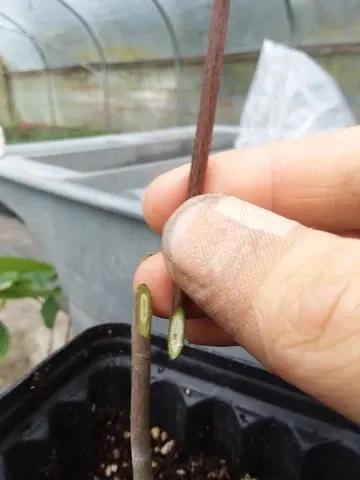
Custom Graft
Please Note: Rootstocks are sold separately.
Custom Grafts orders must include one rootstock per custom graft.
|
Example: 3x Custom Graft - 9.99 3x EMLA 26 Apple Rootstock - 4.49 |
Rescue old fruit trees, or make new trees from that wonderful "but-I-lost-the-name-of-it fruit" tree to share with family members!
All you need is scion wood (current year vigorous shoot) from your favorite fruit tree and a rootstock to graft it to. Learn how to do it yourself (see below) or let us help.
Custom grafting:
We can help you save your favorite unidentified trees. We will be making bench grafts, which work best for apple, pear, plum, and quince. Collect, clean, and store your scion wood following the instructions below. Mail your dormant scion wood to us (we recommend USPS), or drop it off in labeled sealed bags, during February. Please include “Attention Custom Graft” and your order number on the shipping label. Mail to 408 Butts Rd, Morton WA 98356.
Each variety needs to be clearly labeled, and please write your full name and order number on the outside of the bag(s) of scion wood. We cannot provide scion wood, you must send the scion wood to be grafted. The rootstocks are usually not available until late February. Grafting will be completed shortly after the rootstocks become available. They will be worked into the Horticulturist's schedule. They will be shipped with the normal shipping rates, or arrangements can be made for no-contact pick up.
Select the number of custom grafts you need, then select the same number of rootstocks to be grafted to (1 graft per rootstock please, we will not be able to make combo trees). You will need to choose which rootstock you prefer, making sure you select Apple Rootstock for apple trees, Plum Rootstock for plums, Pear Rootstock for pears, and Quince Rootstock for quince.
If you have questions about collecting, storing, or whether your scion wood would work, or about rootstock selection, please e-mail customer service. In the subject line please put “Attention Custom Graft”. Custom grafts are not guaranteed, but every effort will be made to produce viable new trees.
How to Collect Scion Wood:
Cut vigorous, pencil size (1/4” diameter) wood when the tree is dormant (Dec-Feb), and when all of the leaves have dropped. Preferably before a very hard freeze has occurred that might cause damage. Otherwise, only collect scion wood when the ground is not frozen, and the temperature did not go below freezing the night before.
Select only the previous growing season’s new healthy growth. It can be found at the end of branches, or shooting straight up from horizontal arms. It tends to not have side branches or fruit spurs, and has flat, pointed, vegetative buds, not plump, round, flower buds.
Storing the scion wood:
For grafting, you only need 4-6” long pieces, but for storage or easier handling they can be 10-15” long, or just short enough to completely fit inside a sealed plastic bag. Dip the scion wood pieces in a mild bleach solution, 1 part bleach to 9 parts water, and pat dry after 10-15 min’s. Label each scion wood stick (or bundle) if putting more than one variety in a bag, or label each bag with one variety in it. For each bag wet a piece of paper towel and wring out very well, place it in the bag to provide humidity, and seal the bag. Store in a refrigerator (35-40° F), away from fruit or produce, until you are ready to graft or send to us for grafting.
Grafting:
To graft the trees yourself, you will need a grafting knife and grafting bands, see Grafting Supplies. A grafting knife is designed with a single beveled edge that gives a clean straight cut, as opposed to a kitchen knife that has a double beveled edge. For instructions download PNW496E ‘Propagation of woody plants by Budding and Grafting’ from Washington State University Extension, or find the equivalent at your local co-operative extension web site, view videos, or ask about classes in your area.
After care:
Store your newly grafted trees at 60-70ﹾ F for 10-14 days, this allows the cut edges to start healing and produce callus tissue. Then store your trees at 40° F until all danger of frost has past and it is time to plant your trees outside. Plant them in a protected location (such as a garden), 12-24 inches apart for the first year. Then you can transplant them to a permanent location after 1-2 years of growth. Be patient, and look forward to your fruit in 5-7 years!


